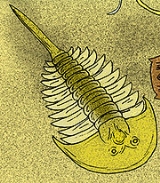
Aglaspida
Encyclopedia
The Aglaspida, more correctly termed Aglaspidida, were a group of small, horseshoe crab-like arthropod
s that were once regarded as basal or ancestral horseshoe crab
s. However they cannot be accommodated within the chelicerates. Now, though, they are regarded as a distinct group, possibly being close to the trilobite
s. The older idea that they link trilobites with Chelicerata
has fallen out of favour.
Aglaspid fossils are found throughout the world, including North America
(upper Mississippi valley, Missouri
and Utah
), Europe
, and Australia
.
As of 1997, Hou & Bergström split off Strabopidae (which were once regarded as being primitive eurypterid
s), including the genera
Strabops, Paleomerus, Parapaleomerus, and Neostrabops, as its own distinct order/taxon, "Strabopida."
Arthropod
An arthropod is an invertebrate animal having an exoskeleton , a segmented body, and jointed appendages. Arthropods are members of the phylum Arthropoda , and include the insects, arachnids, crustaceans, and others...
s that were once regarded as basal or ancestral horseshoe crab
Horseshoe crab
The Atlantic horseshoe crab, Limulus polyphemus, is a marine chelicerate arthropod. Despite its name, it is more closely related to spiders, ticks, and scorpions than to crabs. Horseshoe crabs are most commonly found in the Gulf of Mexico and along the northern Atlantic coast of North America...
s. However they cannot be accommodated within the chelicerates. Now, though, they are regarded as a distinct group, possibly being close to the trilobite
Trilobite
Trilobites are a well-known fossil group of extinct marine arthropods that form the class Trilobita. The first appearance of trilobites in the fossil record defines the base of the Atdabanian stage of the Early Cambrian period , and they flourished throughout the lower Paleozoic era before...
s. The older idea that they link trilobites with Chelicerata
Chelicerata
The subphylum Chelicerata constitutes one of the major subdivisions of the phylum Arthropoda, and includes horseshoe crabs, scorpions, spiders and mites...
has fallen out of favour.
Aglaspid fossils are found throughout the world, including North America
North America
North America is a continent wholly within the Northern Hemisphere and almost wholly within the Western Hemisphere. It is also considered a northern subcontinent of the Americas...
(upper Mississippi valley, Missouri
Missouri
Missouri is a US state located in the Midwestern United States, bordered by Iowa, Illinois, Kentucky, Tennessee, Arkansas, Oklahoma, Kansas and Nebraska. With a 2010 population of 5,988,927, Missouri is the 18th most populous state in the nation and the fifth most populous in the Midwest. It...
and Utah
Utah
Utah is a state in the Western United States. It was the 45th state to join the Union, on January 4, 1896. Approximately 80% of Utah's 2,763,885 people live along the Wasatch Front, centering on Salt Lake City. This leaves vast expanses of the state nearly uninhabited, making the population the...
), Europe
Europe
Europe is, by convention, one of the world's seven continents. Comprising the westernmost peninsula of Eurasia, Europe is generally 'divided' from Asia to its east by the watershed divides of the Ural and Caucasus Mountains, the Ural River, the Caspian and Black Seas, and the waterways connecting...
, and Australia
Australia
Australia , officially the Commonwealth of Australia, is a country in the Southern Hemisphere comprising the mainland of the Australian continent, the island of Tasmania, and numerous smaller islands in the Indian and Pacific Oceans. It is the world's sixth-largest country by total area...
.
As of 1997, Hou & Bergström split off Strabopidae (which were once regarded as being primitive eurypterid
Eurypterid
Eurypterids are an extinct group of arthropods related to arachnids which include the largest known arthropods that ever lived. They are members of the extinct order Eurypterida ; which is the most diverse Paleozoic chelicerate order in terms of species...
s), including the genera
Genus
In biology, a genus is a low-level taxonomic rank used in the biological classification of living and fossil organisms, which is an example of definition by genus and differentia...
Strabops, Paleomerus, Parapaleomerus, and Neostrabops, as its own distinct order/taxon, "Strabopida."
List of Genera
- Aglaspella
- AglaspisAglaspisAglaspis is the type genus of aglaspidid merostomata. These extinct, horseshoe crab-like lived on the seafloor during the Cambrian period.-External links:* at the Paleobiology Database...
- AglaspoidesAglaspoidesAglaspoides is an extinct genus of aglaspid arthropod.-External links:* at the Paleobiology Database...
- AngarocarisAngarocarisAngarocaris is an extinct genus of chelicerate.-External links:* at the Paleobiology Database...
- BeckwithiaBeckwithiaBeckwithia is an extinct genus of Merostomata characterised by a fused tail-plate. It contains one species, Beckwithia typa, although two other species have been ascribed to it...
- Borchgrevingkium
- Craspedops
- Cyclopites
- Flobertia
- Girardevia
- Glypharthrus
- KodymirusKodymirusKodymirus is a problematic genus of Cambrian arthropod, known from the Czech republic, which bears some resemblance to the eurypterids, aglaspidids and chelicerates...
- Neostrabops
- Setaspis
- Sinaglaspis
- Strabops
- Triopus
- Tuboculops
- Uarthrus
External links
- Mikko's Phylogeny ArchiveMikko's Phylogeny ArchiveMikko's Phylogeny Archive is an amateur paleontology website maintained by Mikko Haaramo, a student at the University of Helsinki's Department of Geology, Division of Geology and Palaeontology....
on Aglaspida - Virtual fossli museum on Aglaspida
- Fossilmall Australian Aglaspida
- Merostomata genera
- Enrico Bonino Aglaspida description page (in Italian)

